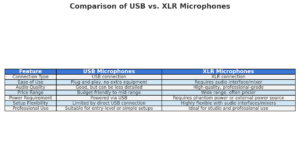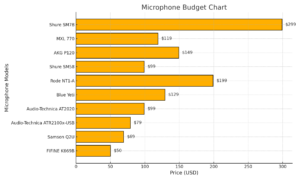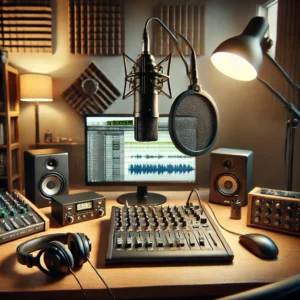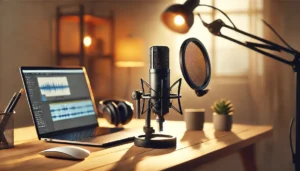Jeremiah_a_smith
Best Microphone for Home Recording: Your Ultimate Guide
Home recording has become more accessible than ever, thanks to advancements in audio technology. Whether you’re a budding podcaster, aspiring musician, or content creator, a good microphone is essential for producing professional-quality audio from the comfort of your home. But how do you choose the best microphone that suits your needs and budget without feeling overwhelmed?
Fear not! This guide breaks down everything you need to know about choosing the best microphone for home recording, categorized by price range, intended use, and other key factors. By the end, you’ll be equipped with all the information to confidently select the ideal mic for your recording goals.
1. Understanding Microphones: Types and Features
Types of Microphones
- Condenser Microphones
- Best suited for vocals, acoustic instruments, and voiceovers.
- Example: Audio-Technica AT2020 ($99) – A versatile and budget-friendly option ideal for vocal clarity.
- Pros: High sensitivity, detailed sound capture.
- Cons: Susceptible to background noise; not ideal for untreated spaces.
- Dynamic Microphones
- Ideal for podcasting, live instruments, or recordings in noisy spaces.
- Example: Shure SM7B ($399) – Known for its warmth and clarity, perfect for podcasts and vocals.
- Pros: Durable, resistant to background noise.
- Cons: Requires amplification (preamp or audio interface).
- USB Microphones
- Plug-and-play convenience for beginners who don’t own professional recording equipment.
- Example: Blue Yeti ($129) – A crowd favorite for home studios and easy podcast setups.
- Pros: Easy to use, no audio interface required.
- Cons: Limited flexibility compared to XLR mic.

2. Budget Breakdown: Microphones for Every Price Range
Here’s a breakdown of the best microphones based on your budget:
Affordable Options (<$100)
Great choices for beginners looking to start small:
- Samson Q2U ($69) – This versatile mic supports both USB and XLR connections, making it an excellent starter option for podcasters.
- FIFINE K669B ($50) – A budget-friendly USB mic for casual recording and streaming.
Mid-Range ($100–$300)
Perfect for serious hobbyists or those looking to upgrade:
- Audio-Technica AT2020 ($99) – A high-quality condenser microphone that strikes the perfect balance between price and performance.
- Rode NT1-A ($229) – Comes with a shock mount and pop filter, making it a bundled deal for vocalists.
Premium Options ($300+)
When audio quality matters most, consider these industry-leading mics:
- Shure SM7B ($399) – Popular for podcasts and voiceovers, loved by creators like Joe Rogan.
- Neumann TLM 102 ($699) – A top-tier condenser mic for studio-quality vocal and instrument recordings.

3. Selecting Microphones for Different Use Cases
Your choice of microphone will largely depend on the type of recording you want to do. Here are some tailored recommendations:
For Podcasting and Voiceovers
- Go for a dynamic microphone that isolates your voice and minimizes background noise.
- Top Picks: Samson Q2U (budget-friendly, USB/XLR), Shure SM58 (durable and reliable).
For Vocals (Singing or Speech)
- A condenser microphone ensures you capture every nuance in your voice.
- Top Picks: Rode NT1 (high-end clarity for singers), Audio-Technica AT4040 (a step up for professionals).
For Instruments (Guitar, Drums, Piano, etc.)
- Mics with high sound pressure level (SPL) are essential for loud instruments.
- Top Picks: Shure SM57 (excellent for guitars and drums), AKG C214 (ideal for acoustic instruments).
For Multi-Purpose Use
- Need one mic for various applications? Choose a flexible option with multiple polar patterns.
- Top Pick: Blue Yeti ($129) – Switch between cardioid, omnidirectional, and bidirectional modes as needed.
4. Accessories and Setup Tips for Home Recording
Beyond the microphone itself, these accessories will level up your home recording setup:
- Pop Filters: Reduce plosive sounds (e.g., “P” and “B” pops) for cleaner vocals.
- Shock Mounts: Isolate your mic from desk vibrations or accidental bumps.
- Mic Stands: Improve mic placement for better sound quality and comfort.
DIY Soundproofing Tips
- Use soft furnishings like carpets, curtains, or upholstered furniture to absorb echo.
- Install affordable acoustic foam panels to reduce reflections and noise.
- Portable vocal booths or DIY absorptive shields can further enhance sound quality on a budget.
5. Emerging Trends and Innovations
The world of microphones is continuously evolving with exciting new features and technologies:
- Wireless Microphones: Models like the Rode Wireless GO II offer mobility and clutter-free setups.
- AI Enhancements: Microphones with onboard digital signal processing (DSP) assist beginners with auto-leveling and EQ adjustments (e.g., Elgato Wave:3).
- Hybrid Mics: USB/XLR microphones (e.g., Samson Q2U) cater to both beginners and users with traditional audio setups.
6. Microphone Maintenance and Longevity Tips
Taking care of your microphone ensures it lasts for years:
- Store mics in a dust-free case or pouch when not in use.
- Wipe the grille with a dry or slightly damp cloth regularly.
- Avoid exposing your microphone to extreme temperature or humidity.
Bonus Tip: For condenser microphones, use a silica gel packet in storage to prevent moisture damage.
Conclusion
Key Takeaways
- Whether you’re recording vocals, podcasts, or instruments, the right microphone is essential for achieving professional-quality audio at home.
- Beginners can start small with USB mics like the Samson Q2U, while serious hobbyists should consider condenser options like the Audio-Technica AT2020.
- Accessories like pop filters and soundproofing make as much difference as the microphone itself.
Your Next Step
Ready to upgrade your home recording setup? Explore our top microphone recommendations and elevate your creativity today!
Best Budget Microphones for Home Recording: Top Picks and Essential Tips
Recording high-quality audio at home no longer requires a huge investment. With an ever-growing range of budget-friendly microphones, anyone can capture professional-sounding vocals, podcasts, or streaming audio from the comfort of their own space. In this guide, we’ll explore the top budget microphones for home recording, covering their features, pros, cons, and practical setup tips.
USB vs. XLR: Which Should You Choose?
When hunting for a budget microphone, the first big decision is often between a USB or XLR microphone.
- USB Microphones
- Pros: Plug-and-play simplicity, no external audio interface required, perfect for beginners.
- Cons: Less expandable if you want to upgrade your gear in the future.
- XLR Microphones
- Pros: Scalable setup; works with mixers and audio interfaces; generally robust signal quality.
- Cons: Requires an audio interface (additional cost) and more setup time.

Understanding Condenser vs. Dynamic
- Condenser Microphones
- Highly sensitive and detailed, capturing crisp audio—ideal for vocals and acoustic instruments.
- More prone to background noise, so best used in quiet environments.
- Dynamic Microphones
- Less sensitive, perfect for untreated spaces or where background noise is a concern.
- Often more durable, which can be great for live performances or travel.
Key Features to Consider
- Polar Pattern
- A cardioid pattern (common in many budget mics) focuses on sound from the front, reducing ambient noise.
- Frequency Response
- Aim for a range around 20Hz–20kHz for capturing a full spectrum of audio detail.
- Build Quality
- Metal housings typically last longer. Read reviews to confirm if the mic holds up over time.
[INSERT VISUAL: An infographic illustrating polar patterns in a microphone diagram]
- Alt text: “Diagram showing how a cardioid polar pattern captures sound primarily from the front.”
Top 5 Budget Microphone Picks
Below are five popular budget microphones that consistently receive high ratings from home recording enthusiasts.
1. Samson Q2U (Dynamic, USB/XLR)
- Price: $60–$70
- Why It’s Great:
- Dual connectivity (USB and XLR) for extra flexibility.
- Durable and offers a decent, warm sound for vocals, podcasts, and live streaming.
[INSERT VISUAL: Photo of Samson Q2U microphone package]
- Alt text: “Samson Q2U microphone with its accessories, including the mic clip and USB cable.”
2. Audio-Technica AT2020 (Condenser, XLR)
- Price: $99–$120
- Why It’s Great:
- Delivers clear, detailed audio quality often heard in pro studios.
- Ideal for singers, instrumentalists, and voice-over artists.
3. Blue Snowball iCE (Condenser, USB)
- Price: $50–$70
- Why It’s Great:
- Extremely user-friendly; just plug into your computer and go.
- Popular for podcasting, YouTube videos, and casual voice recording.
4. Behringer C-1 (Condenser, XLR)
- Price: $50–$60
- Why It’s Great:
- A reliable, low-cost option for beginners who want to explore XLR.
- Solid for vocals and basic instrument recording, though it benefits from a decently quiet room.
5. Rode NT-USB Mini (Condenser, USB)
- Price: $99–$120
- Why It’s Great:
- Sturdy build and compact design; includes a built-in pop filter.
- Great choice if you need a smaller footprint on your desk.
Practical Setup Tips
Even the best microphone can only do so much in a poor recording environment. Here are some ways to maximize sound quality:
- Positioning
- Keep your mic 6–12 inches from your mouth for clear, warm audio.
- Use a pop filter to reduce harsh ‘p’ and ‘b’ sounds.
- Acoustic Treatment
- Hang heavy curtains, use acoustic panels, or even DIY options like moving blankets to reduce reflections.
- Avoid recording near noisy appliances or open windows if possible.
- Software & Workflow
- Start with free or low-cost DAWs like Audacity or Reaper.
- Check your recording levels, aiming for peaks between -12dB and -6dB to avoid clipping.
[INSERT VISUAL: An infographic of a basic home studio setup]
- Alt text: “Diagram showing a microphone on a stand with a pop filter, acoustic panels on walls, and a computer with recording software open.”
Conclusion & Recommendations
Choosing the right budget microphone depends on your immediate needs and whether you plan to expand your gear later:
- USB Microphones (e.g., Blue Snowball iCE, Rode NT-USB Mini, Samson Q2U) are great for a quick, plug-and-play setup.
- XLR Microphones (e.g., Audio-Technica AT2020, Behringer C-1) shine if you’ll eventually invest in a more advanced home studio.
No matter which mic you choose, remember that room acoustics and proper technique play just as big a role in capturing quality audio. Take the time to position your mic correctly, monitor your input levels, and reduce ambient noise wherever possible.
[INSERT VISUAL: A simple “cheat sheet” graphic summarizing each mic choice and its best use case]
- Alt text: “Cheat sheet comparing Samson Q2U, Audio-Technica AT2020, Blue Snowball iCE, Behringer C-1, and Rode NT-USB Mini in a quick-reference chart.”
Ready to upgrade your home recording setup? Pick one of these budget-friendly microphones and start creating professional-sounding audio for your podcasts, music, or voice-overs today. Don’t forget to explore pop filters, mic stands, and basic acoustic treatments for the best results!
Next Show Details
🎤 Subb Zero Sessions – Rap Showcase 🎤
📅 January 31st
📍 Mia Breakfast Bar & Grill
1716 W Layton Ave, Milwaukee, WI
🚪 Doors Open at 8 PM
About the Event:
Are you ready to experience the chillest vibes and hottest beats? Subb Zero Sessions is where rap artistry takes center stage. Hosted by ATR with electrifying sound by @DJ_ulit, this night is set to be a game-changer for hip-hop lovers and artists alike.
Whether you’re an artist or a fan, this is your chance to connect, vibe, and enjoy some incredible performances.
Event Details:
📅 Date: January 31, 2025
🕒 Time: Doors open at 8 PM (Artist check-in begins at 7 PM)
📍 Location: Mia Breakfast Bar & Grill, 1716 W Layton Ave, Milwaukee, WI
🎟️ Entry Fee: $20
What to Expect:
🔥 A lineup of incredible rap performances.
🎧 Live DJ sets by @DJ_ulit to keep the energy flowing.
🎤 A platform for artists to showcase their skills.
Get Involved:
- Artists: Be ready to check in starting at 7 PM.
- Fans: Arrive early to grab the best spot and soak in the vibe.
Stay Connected:
Follow us for updates, sneak peeks, and more:
[Insert Social Media Links]
This is a night you won’t want to miss—let’s make it epic!


